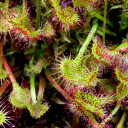My corner of Colorado is home to high peaks and deep glacial lakes – this montane and alpine zone hosts characteristic species like pines, firs, and a host of perennial herbs and shrubs like Erigeron spp., Potentilla sp. and Veratrum tenuipetalum. Here you can see several of these species near a wilderness lake at the base of Snowmass Mountain.
In this part of the world it is very rare to find another type of habitat: the fen. A fen is a groundwater-fed wetland that has unusual water chemistry – typically alkaline, with high levels of dissolved minerals.
So travel some miles from that lake, and you may be lucky enough to find a fen if you know where to look! Here you can see reddish-brown water whose color comes from high levels of iron compounds.
Fens are often associated with carnivorous plants. Because of mineral nutrient limitations in the soil and water, some plants have evolved the ability to obtain these nutrients from animal prey. This species is no exception. The round-leaf sundew, Drosera rotundifolia, can be found growing unobtrusively near the water’s edge if one is willing to search patiently. The whole plant is no more than a few centimeters tall.
This plant is a rare sighting – across the entirety of the US Forest Service’s Region 2 (Wyoming, the Dakotas, Colorado, Nebraska, and Kansas), it is known to occur at just four sites. Tread lightly!




Comments
3 responses to “Out of place”
Ben – these photos are amazing! Thank you for sharing with the RMBL world!
Hi Ben, I continue to enjoy your blog. If a fen has high levels of dissolved minerals, then why do species need to obtain nutrients from animal prey?
Thanks Emma! Fens have high levels of minerals that aren’t useful to plants – not much biologically available nitrogen and phosphorus, in particular. These nutrients are either not input to the system, or quickly used by microbes.